June 3, 2024
As we approach the eagerly anticipated reopening of The Frick Collection’s renovated Fifth Avenue buildings, we’re taking a moment to look back on the final special exhibition held at Frick Madison, our temporary home that closed on March 3, 2024. The critically acclaimed show Bellini and Giorgione in the House of Taddeo Contarini paired Giovanni Bellini’s St. Francis in the Desert from our collection with Giorgione’s Three Philosophers, on rare loan from the Kunsthistorisches Museum, Vienna. Both masterpieces were once owned by Taddeo Contarini, a Venetian merchant and art collector, and our presentation reunited the two works for the first time in four centuries.
We know of the two paintings’ inclusion in Contarini’s collection thanks to Marcantonio Michiel’s 1525 inventory of his palazzo in the Santa Fosca parish of Venice, which recorded ten paintings in total. Using the Frick Art Reference Library’s Photoarchive collection, which contains approximately 1.2 million photographic reproductions of works of art, we can virtually explore five of the other eight paintings that hung alongside Bellini and Giorgione’s landscapes in the palace. The abundant information accompanying Photoarchive reproductions—including attribution, provenance, condition history, and bibliography—enables us to trace many works of art to their origins, traversing the centuries as they were bought, sold, bequeathed, and displayed in different contexts.
While many questions remain about Taddeo’s treasures, what follows provides a peek into his surroundings at Casa Contarini.
-
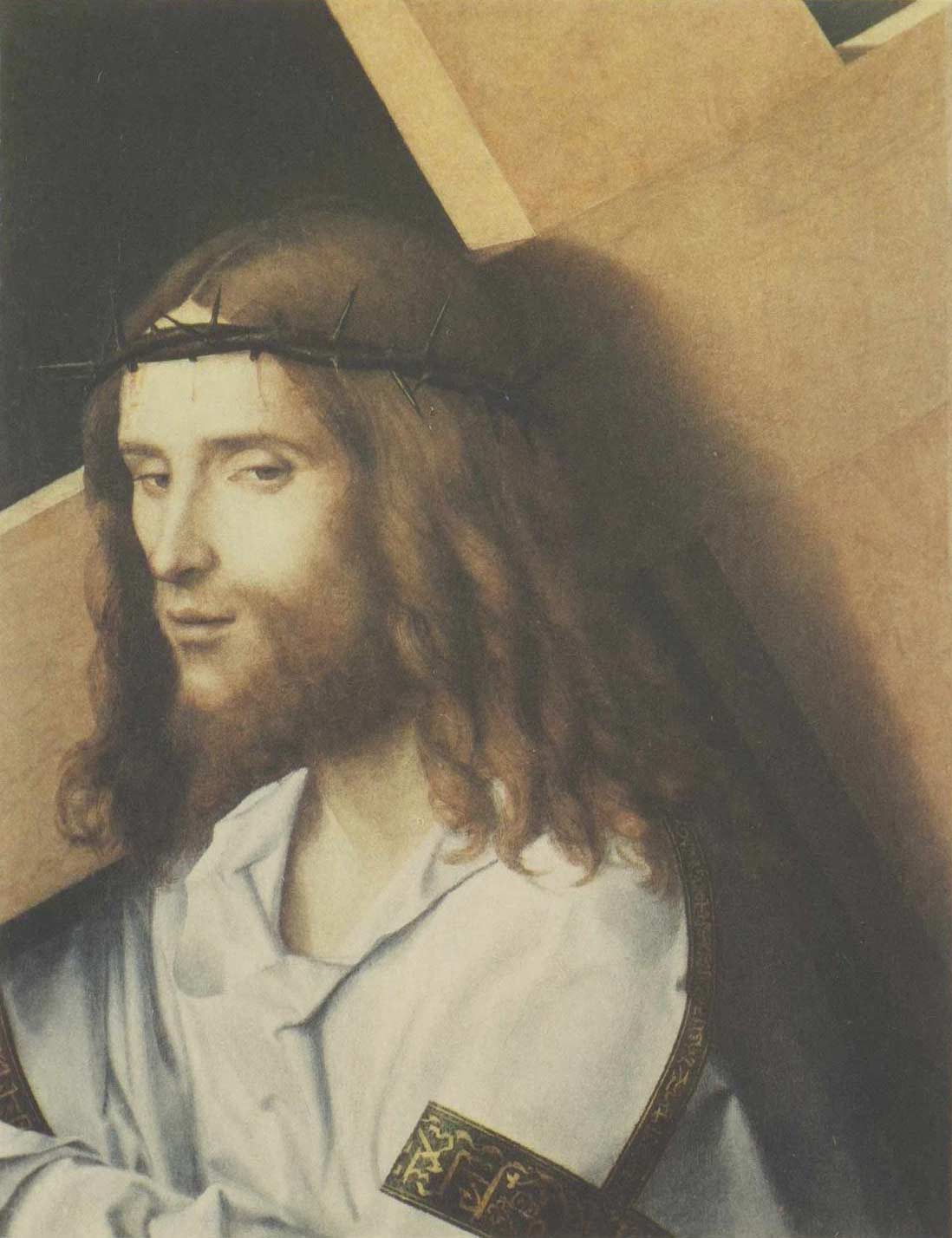 Reproduction of follower of Giovanni Bellini (ca. 1424/35–1516), Christ Carrying the Cross, ca. 1500–10, oil on panel, Frick Art Reference Library Photoarchive
Reproduction of follower of Giovanni Bellini (ca. 1424/35–1516), Christ Carrying the Cross, ca. 1500–10, oil on panel, Frick Art Reference Library PhotoarchiveThe painting of Christ with the cross on his shoulders, up to the shoulders, was by the hand of Giovanni Bellini.—Marcantonio Michiel, 1525
Taddeo was a fan of Giovanni Bellini, it seems, for in the same inventory, Michiel describes two works by the artist besides the St. Francis. One is a panel depicting Christ carrying the cross, which was still in the Contarini household in 1556, according to another inventory that was conducted after the death of Taddeo’s son, Dario. Because of Michiel’s generic description and the existence of several paintings by Bellini of this subject (a similar composition, by an artist in Bellini’s circle, is at the Isabella Stewart Gardner Museum, Boston), it is difficult to identify which one was in the Contarini collection. Over time, many scholars, including past Photoarchivists, have settled on a painting in the collection of the Toledo Museum of Art (reproduced above), now believed to be by an assistant or follower of Bellini.
-
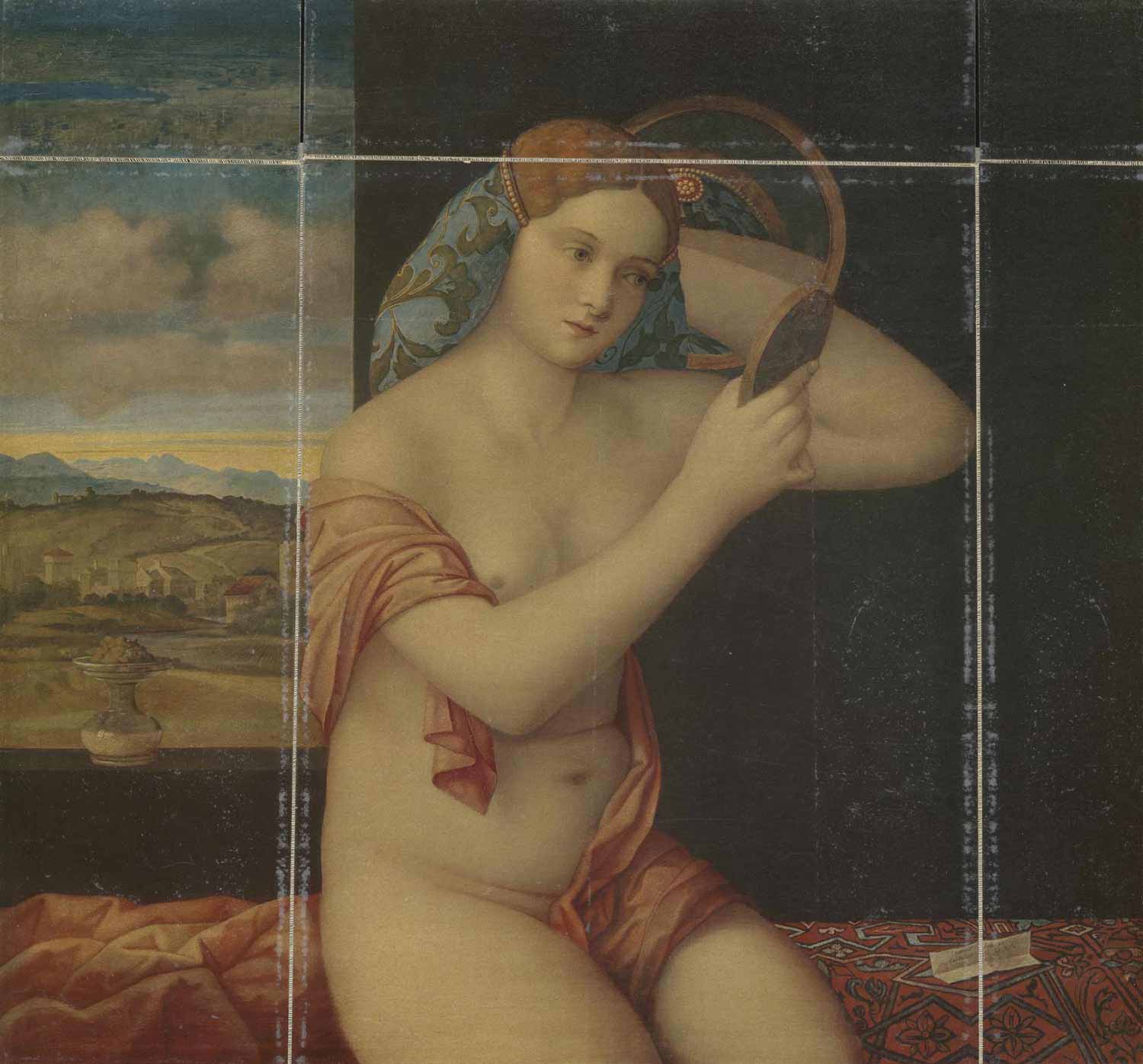 Reproduction of Giovanni Bellini, Woman with a Mirror, 1515, oil on panel, Frick Art Reference Library Photoarchive
Reproduction of Giovanni Bellini, Woman with a Mirror, 1515, oil on panel, Frick Art Reference Library PhotoarchiveThe small painting of the woman portrayed life-size up to her shoulders, was by the hand of Giovanni Bellini.—Michiel
It is harder to identify Taddeo’s third Bellini. Woman with a Mirror (above) was recorded in Dario Contarini’s possession in 1556, in the same room as Christ Carrying the Cross and St. Francis in the Desert. However, it is not certain that this was the painting Michiel described.
Whereas Taddeo’s inventory was made by a scholar and recorded only artworks, Dario’s inventory was drawn up as part of his will and surveyed approximately seventeen different rooms, recording valuables, pieces of furniture, and a host of household goods. It is possible, therefore, that Michiel neglected to include or more fully describe Woman with a Mirror, or that Dario acquired it between 1525 and 1556. (If it is the case that Taddeo had it in his home, that means Dario moved St. Francis at some point, as if to showcase all three Bellinis in the same space.) We do know that, like The Three Philosophers, Woman with a Mirror was later acquired by Archduke Leopold Wilhelm in Brussels and Vienna, and both paintings subsequently entered the Kunsthistorisches collection, making Woman with a Mirror’s connection to the Contarinis stronger.
-
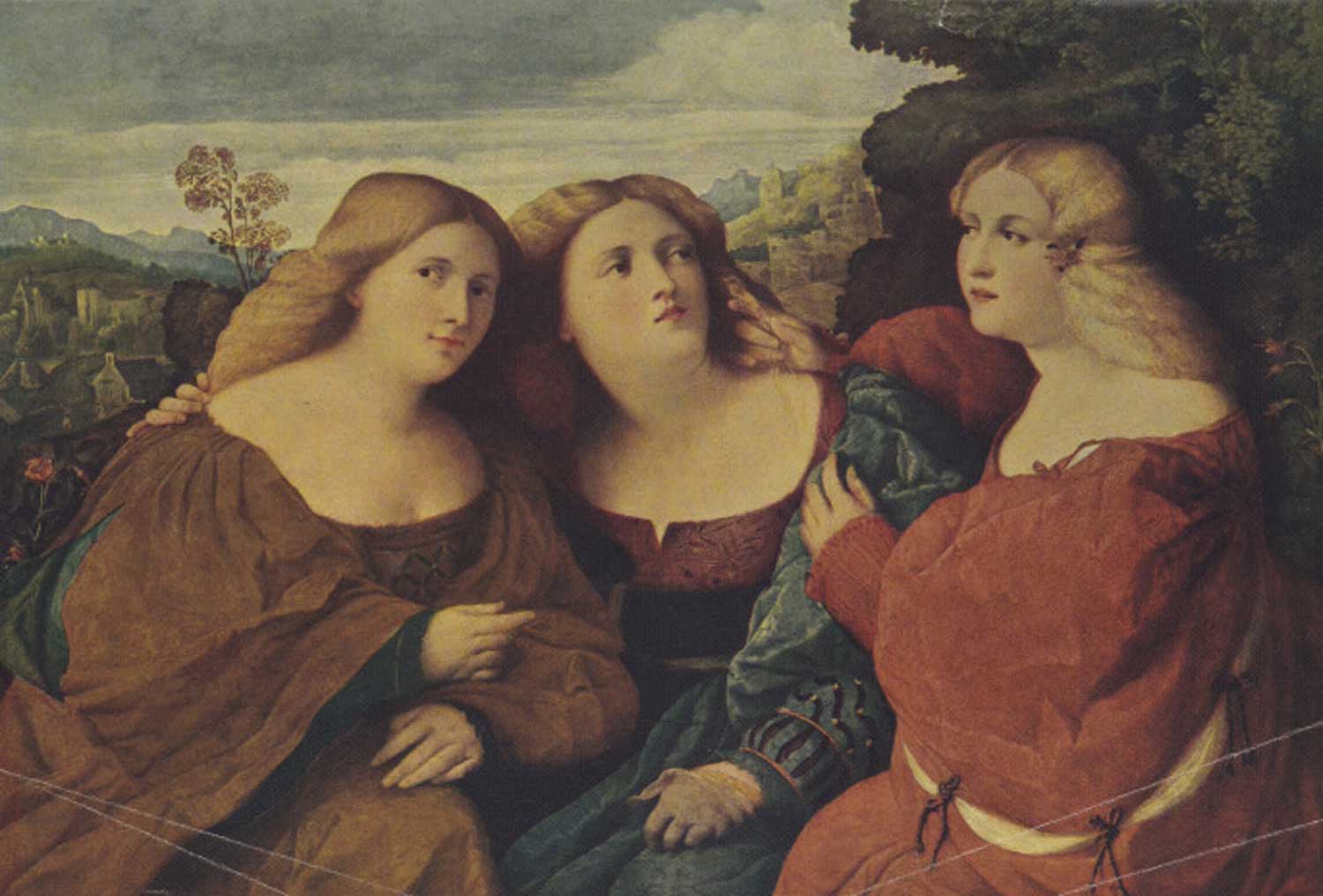 Reproduction of Palma il Vecchio (ca. 1480–1528), The Three Sisters (or Three Women), ca. 1518–20, oil on panel, Frick Art Reference Library Photoarchive
Reproduction of Palma il Vecchio (ca. 1480–1528), The Three Sisters (or Three Women), ca. 1518–20, oil on panel, Frick Art Reference Library PhotoarchiveThe painting of the three women portrayed life-size up to the waist, was by the hand of Palma.—Michiel
The Palma il Vecchio painting recorded as Three Women in the 1525 and 1556 inventories was passed down through the Contarini family (later the Giustinian and Corner families, by marriage) until it was sold, in 1743, to an agent in Dresden, where it still resides in the Gemäldegalerie Alte Meister. Art historians have interpreted the subjects as courtesans, the Three Graces, or, most likely, as sisters. This is the only painting recorded by Michiel in Contarini’s collection that is firmly identified with a known work of art.
-
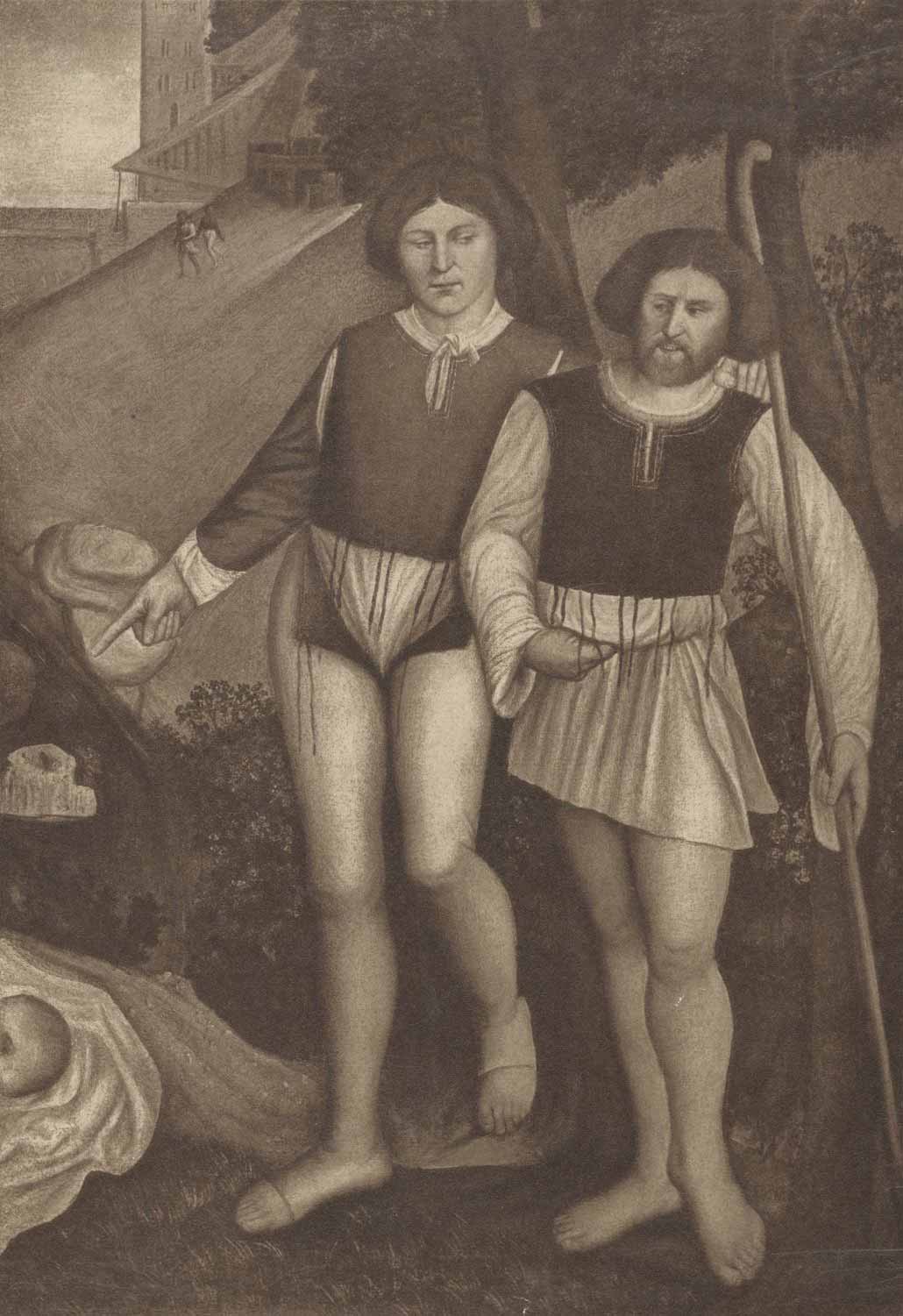 Reproduction of a copy after Giorgione, Two Shepherds, sixteenth century, oil on canvas, Frick Art Reference Library Photoarchive
Reproduction of a copy after Giorgione, Two Shepherds, sixteenth century, oil on canvas, Frick Art Reference Library PhotoarchiveThe Canvas of the landscape with the birth of Paris with two shepherds standing, was by the hand of Giorgio from Castelfranco, and was among his early works.—Michiel
Both Taddeo’s and Dario’s inventories also mention a landscape by Giorgione depicting the birth of Paris, the mythological prince of Troy, with two shepherds standing. In 1525, it hung in a room together with St. Francis in the Desert. It later traveled to Brussels (with The Three Philosophers and Bellini’s Woman with a Mirror) and then seemingly disappeared—but not before the Flemish artist David Teniers the Younger made a copy at the picture gallery of Leopold Wilhelm (below).
 Reproduction of David Teniers the Younger (1610–1690) after Giorgione, The Finding of Paris, seventeenth century, oil on canvas, Frick Art Reference Library Photoarchive
Reproduction of David Teniers the Younger (1610–1690) after Giorgione, The Finding of Paris, seventeenth century, oil on canvas, Frick Art Reference Library PhotoarchiveSome scholars have proposed that a panel depicting two standing shepherds at the Museum of Fine Arts, Budapest (reproduced above), may be a fragment of Giorgione’s canvas owned by the Contarinis. It resembles Teniers’s copy in composition but is closer to the style of Giorgione. The severe cropping indicates, too, that it was once part of a larger work. This theory, however, is still up for debate, and the MFA Budapest identifies it as a copy after Giorgione.
-
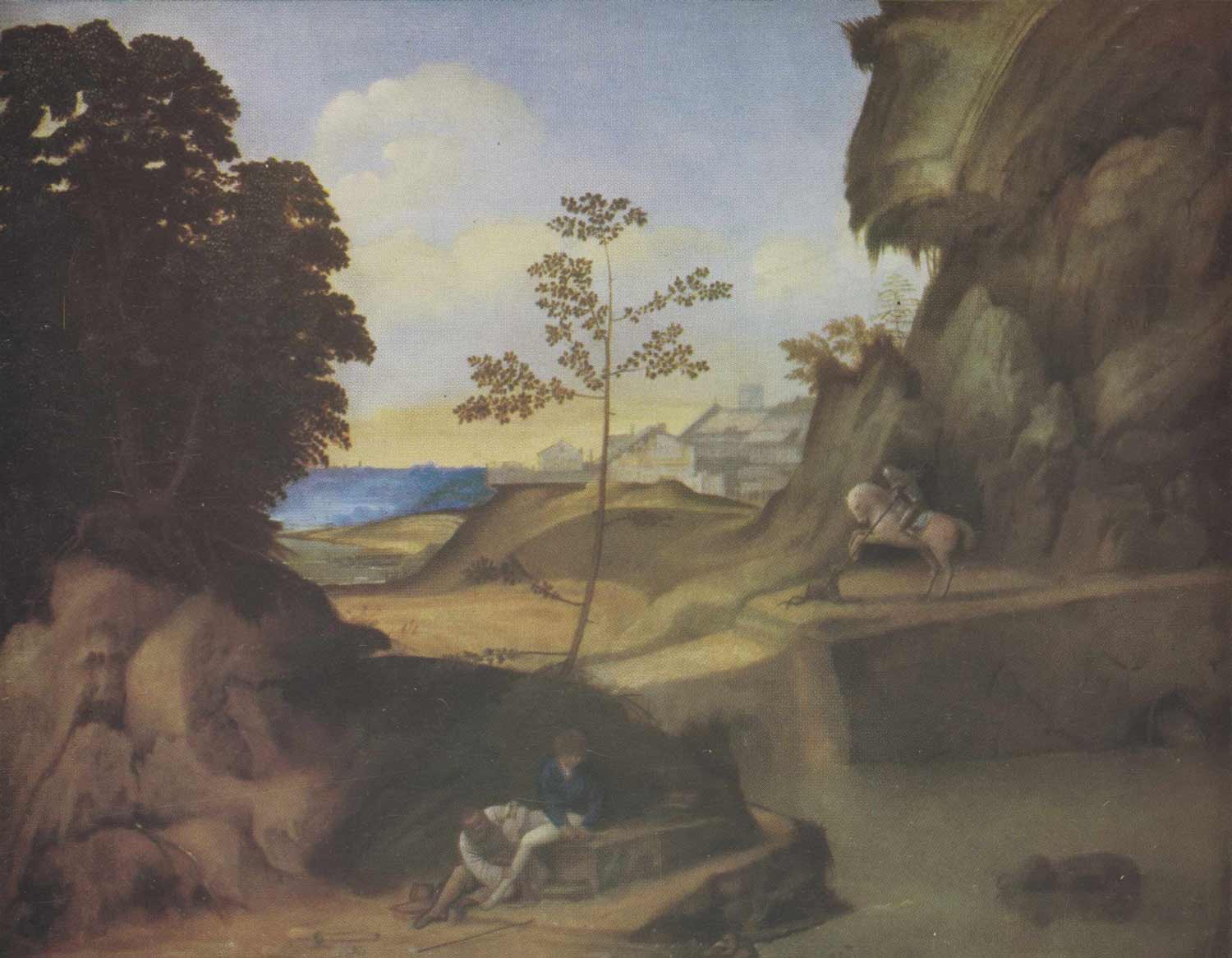 Reproduction of Giorgione (ca. 1477–1510), Il Tramonto (The Sunset), 1506–10, oil on canvas, Frick Art Reference Library Photoarchive
Reproduction of Giorgione (ca. 1477–1510), Il Tramonto (The Sunset), 1506–10, oil on canvas, Frick Art Reference Library PhotoarchiveThe large Canvas in oil of hell with Aeneas and Anchises, was by the hand of Giorgio from Castelfranco.—Michiel
Like with Bellini, Taddeo was a Giorgione enthusiast. His third painting by the artist was a hellscape with Aeneas and Anchises, mythological figures who fled Troy after its defeat by the Greeks. The painting has long been thought to be lost, but in recent years, scholars have made connections with another Giorgione painting at the National Gallery in London, Il Tramonto (The Sunset). This painting is elusive in several ways. The subject—and hence its title—is vague, and the figures have historically been identified as Saints Roch, Gothardus, George, and Anthony Abbot.
The painting’s restorations further muddy the waters. The canvas underwent treatment soon after its fortuitous discovery, in bad condition, in a storeroom in 1932/33; documentation of this restoration in the Photoarchive (below) probably gives us the best idea of the painting’s original appearance. Photographs taken after later restorations, meanwhile, reveal extensive overpainting, especially on the right third of the canvas. Nonetheless, with a closer look at Virgil’s Aeneid and other scholarly clues (including a letter referencing a “painting of a night”), it may be the case that Il Tramonto is indeed the lost Aeneas and Anchises.
Restorations of Giorgione’s Il Tramonto documented in the Photoarchive
1) Before first restoration, 1932/332) After first restoration, post-1932/333) After later restorations, ca. 1960–62
As shown, the images and documentation in the Frick Photoarchive give us many important tools to trace the circuitous paths of works of art through changes in ownership, condition, attribution, and interpretation over time. The Bellini and Giorgione in the House of Taddeo Contarini exhibition was a marvel not only for its reunion of two incredible Venetian Renaissance paintings, but also for the scholarly discoveries linking the two works to a shared history in Contarini’s palazzo. Even though the show and Frick Madison have closed their doors, the Photoarchive opens a window into art collections of the past, allowing us to appreciate Taddeo’s treasures in perpetuity, as he might have five centuries ago.
Explore these works and many more from the Photoarchive in the Frick Digital Collections.
Sources
“Identified as a Famous Giorgione Long Considered as Lost.” Illustrated London News. November 4, 1933, 741.
Salomon, Xavier F. Bellini and Giorgione in the House of Taddeo Contarini. New York: The Frick Collection, 2023.
Schier, Rudolf. “Is Giorgione’s Inferno with Aeneas and Anchises Really Lost?” Vergilius 65 (2019): 61–98.









